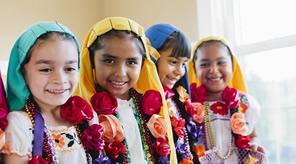Stephanie Margetts, executive director of Holy Rosary Regional School/Juan Diego Academy (HRRS/JDA) in Tacoma, Wash., says she has seen the future—and heard it, too. She is leading an educational innovation called two-way immersion, or dual-language instruction that is transforming this Catholic school with a previously shrinking enrollment.
"Now, you walk in and you feel the energy of a bicultural school that celebrates the English and Spanish languages equally," Margetts said. Enrollment, spanning pre-K for three-year-olds through eighth grade, increased 28 percent last year to 191 currently.
"Now, you walk in and you feel the energy of a bicultural school that celebrates the English and Spanish languages equally"
The student body is roughly half English-dominant, half Spanish-dominant. Pre-schoolers, regardless of their dominant tongue, spend their whole day speaking 100% Spanish; kindergarteners follow a 90% Spanish and 10% English model; and as of 2015, grades 1-3 maintain a 50-50 schedule, rotating one day totally in Spanish with the next immersed in English. Over several years, the approach will climb age levels, up through grade 8.
"We've created a model that people want," Margetts said. Reaching out to a working class region of the state where diverse families share high aspirations for their children, "the model allows us to serve, to bring cultures together. That's an exciting part of what we've been doing."
A combination of incremental changes has kept every day exciting for students. In 2010, Holy Rosary's enrollment had declined to 101; the Fulcrum Foundation, providing financial support to students in the Seattle Archdiocese, consulted with the foundation's diversity committee to establish the first ever two-way immersion program in the archdiocese. The school continues to seek teachers with subject-area knowledge who are bilingual.
Experienced mentors have come together to help make the investment in HRRS/JDA bear fruit. A bilingual, bicultural teacher already on their staff became the leader of this mission—building a Catholic school whose curriculum is fully aligned with the changing demographics of the Catholic Church. An estimated 35-40% of Catholics in the U.S. today are Latino.
In 2011, HRRA/JDA joined the Two-Way Immersion Network for Catholic Schools (TWIN-CS) initiative at Boston College's Lynch School of Education. Dr. Tim Uhl, now superintendent of schools for the Diocese of Helena, led Holy Rosary's transition as its principal. Dr. Bridget Yaden has worked closely with the school as a board member and as chair of a local university's Hispanic studies department.
An estimated 35-40% of Catholics in the U.S. today are Latino.
Margetts arrived at HRRS/JDA for 2014-2015 from Sacred Heart School in Washington, D.C. Sacred Heart adopted dual-language instruction 16 years ago. Along with Escuela Guadalupe in Denver, Sacred Heart was one of the first Catholic schools in the United States to implement two-way immersion. For the past three years, TWIN-CS has supported other schools adopting this model (close to 20 in total).
Elise Heil, who leads Sacred Heart as its principal today, said the school's enrollment has held steady around 200 students, with the two-way immersion model consistently appealing to many parents from various backgrounds, some of whom can utilize the District's school voucher program.
This model helps schools garner interest from parents because they see it boosting academic rigor and student readiness for a diverse culture. English language-dominant families see fluency in Spanish preparing their children for a multilingual society, Heil said, adding that numerous Spanish language-dominant parents appreciate the life-skills development as well as the school's Catholic identity. Schools have become more intentional in how to engage all families in embracing diversity.
Heill noted that immersion fosters solidarity because "everybody is a language learner." But this two-way approach is not easily replicable among all schools, she said.
"This is still a very new model," although the diverse, competitive D.C. education marketplace has prompted more ventures into multiple-language immersion. The model is familiar in many public schools around the country, but it is generating insights as more schools implement it.
"Everybody is a language learner"
"The younger you start, the better," Heil said, recommending that a school initiate the approach among three- and four-year-old preschoolers, then add grades incrementally over a period of years.
Sacred Heart is sharing its expertise with some of the newcomers. Heil said every school experiences challenges, including her own. Non-bilingual applicants cannot be accepted beyond second grade. No Catholic high schools in the area replicate the approach, so no long-term K-through-12 continuity exists. The model's major sectors of growing student enrollment are in the pre-K classes.
Luis Ricardo Fraga, Ph.D., who helped start HRRS/JDA in Tacoma as a board member with the Fulcrum Foundation, continues to study the approach closely among his research topics as the Arthur Foundation Endowed Professor of Transformative Latino Leadership at the University of Notre Dame. As a political scientist and fellow of the Institute for Educational Initiatives, he has written about Holy Rosary's transition.
"Two-way immersion in Catholic schools can be an effective mechanism for building intercultural communities that capture the richness of diverse communities," he said. "As the Catholic Church in the United States becomes more and more multicultural, two-way immersion values both English and Spanish languages and cultures in ways fully consistent with recent statements of the U.S. Conference of Catholic Bishops."
Fraga and other scholars have noted that the approach is well-suited to Catholic values—a respect for the dignity of distinct cultures, the notion of a "common good" to be pursued by all, and a special care for those on society's margins.
Although the resources available for language education models will differ among schools, the stewardship of those resources takes place in a strong family context, as Heil pointed out.
"We're kind of a home for many immigrant families, and the Catholic piece is something that brings us all together," she said of Sacred Heart School. "We have a shared mission and a shared goal. Becoming a bilingual school really benefits the entire population."

